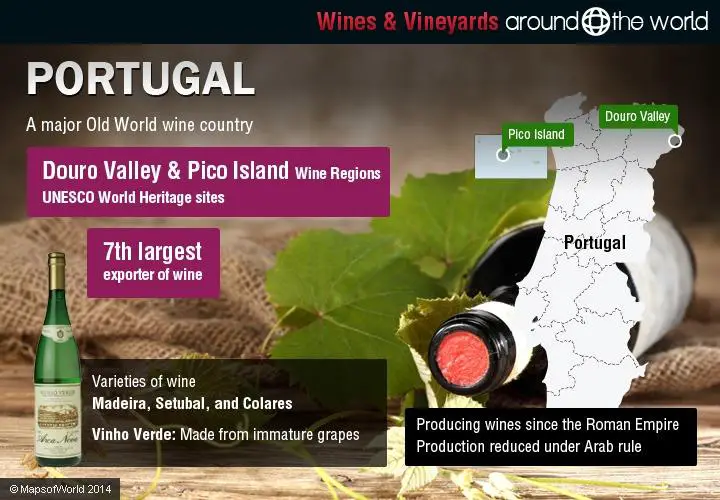Blog
Old World Wines- Portugal

Official Wine Categories
DOC or DOP
At the top level of the European wine hierarchy, Portugal has 31 DOCs/DOPs. At the moment, both of these terms are used in Portugal, the traditional local ‘DOC’ (Denominação de Origem Controlada) meaning Controlled Designation of Origin, while the new pan-European ‘DOP’ (Denominação de Origem Protegida) means Protected Designation of Origin. Each of these regions has its own strictly defined geographical boundaries – note that the map numbers only go up to 29 because two of the regions, Douro and Port and Madeira and Madeirense, have the same ‘footprint’ and are numbered together. DOC regulations also prescribe maximum grape yields, recommended and permitted grape varieties and various other things, and all the wines have to be officially tasted, tested and approved.
IG or IGP (Vinho Regional)
The whole of the country is divided into 14 ‘Regional Wine’ areas. Wines from these areas have for years been labelled in Portugal as Vinho Regional. Now the European Union has introduced new titles for this category of wine: ‘IG’, meaning ‘Geographical Indication’ or ‘IGP’ – ‘Protected Geographical Indication.’ Most Portuguese regions have chosen to keep the old denomination, VR. Rules for making Vinho Regional are much less stringent than those that govern DOC wines. Nevertheless, many prestigious Portuguese wines are classified as Vinho Regional. This is often because the producer has chosen to use grape varieties that are not permitted for the local DOC, or at least not in those particular combinations or proportions.The looser regulations for Vinho Regional give producers greater scope for individuality, although these wines still have to fulfil certain criteria as to grape variety, minimum alcohol content and so on.
Vinho (Wine)
Vinhos (Wines) are Portugal’s simplest wines, subject to none of the rules stipulated for quality or regional wines. Note, however, that a very few really stunning wines are labelled simply as table wines. These tend to be from ambitious growers who have chosen to work outside the official rules, and have deliberately classified their wine as table wine.
Wine Regions
Vinho Verde
Vinho Verde is the biggest wine producing region in Portugal, located up in the cool, rainy, verdant north west. The vines grow in fertile, granite soils along rivers that flow from the mountains of the east to burst out into the ocean between golden surfing beaches.
Main white grapes (varying according to sub-region):
- Alvarinho, Arinto Avesso, Azal, Loureiro and Trajadura
Main red grapes (varying according to sub-region):
- Alvarelhão, Amaral, Borraçal, Espadeiro, Padeiro, Pedral, Rabo de Anho and Vinhão.
Távora-Varosa
This is a small, remote, mountainous region in the north of the VR Beiras, bordering on the Douro to the north, and the Dão region to the south. Half the grapes in the older vineyards are Malvasia Fina, but for a century or more Távora-Varosa has also had significant plantings of Chardonnay and Pinot Noir (two of the major grapes of the Champagne region of France) and more are being planted.
Porto and Douro
Long famous as the source of port wine, the Douro is now also renowned for its fine, rich unfortified wines, both red and white.
Main white grapes:
- Viosinho, Malvasia Fina, Gouveio, Rabigato, Côdega, Donzelinho Branco, Esgana Cão and Folgazão
Main red grapes:
- Touriga Nacional, Tinta Roriz (Aragonez), Touriga Franca, Tinta Barroca, Tinto Cão, Sousão, Bastardo, Mourisco Tinto, Castelão, Rufete, Tinta Amarela (Trincadeira) and Tinta Francisca
Lisboa
West and north of the city of Lisbon, the Lisboa wine region was until recently known as Estremadura. A lot of wine is made here, much of it in co-operatives, in a very wide variety of styles and qualities. This region where the “vinho regional” Lisboa is predominant also has nine DOC.
Main white grapes:
- Arinto, Fernão Pires, Malvasia, Seara-Nova and Vital
Main red grapes:
- Alicante Bouschet, Aragonez, Castelão, Tinta Miúda, Touriga Franca, Touriga Nacional and Trincadeira
Alentejo
The Alentejo region covers about a third of Portugal, and winemakers in the remaining two-thirds can often be heard to complain about the popularity of Alentejo wines.
Main red grapes (variable according to sub-region):
- Aragonez, Trincadeira, Castelão, Alfrocheiro and Alicante Bouschet
Main white grapes (variable according to sub-region):
- Arinto, Antão Vaz, Roupeiro, Fernão Pires, Perrum
Madeira
Madeira’s fortified wines keep practically for ever – they have been known to survive for more than two centuries. Madeira’s vineyards are fragmented into tiny plots along terraces carved into the volcanic slopes. Most vines are trained on pergolas. The grapes are harvested between mid-August and mid-October, small-scale growers delivering sometimes tiny quantities of grapes.
Authorized grapes for DOP Madeirense and IGP Terras Madeirenses:
- Verdelho, Malvasia Fina (Boal), Sercial, Malvasia, Folgasão (Terrantez), Chardonnay, Chenin, Bastardo, Cabernet Sauvignon, Complexa, Deliciosa, Merlot, Tinta Barroca, Tinta Negra, Touriga Francesa, and Touriga Nacional.
Main grapes for DOP Madeira:
- Tinta Negra, Sercial, Boal, Malvasia, Terrantez and Verdelho
